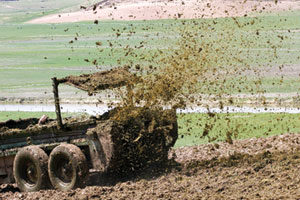Such variations are due to the different kinds of housing (e.g. bedding packs or freestalls) and, of course, to the different methods of manure storage.
In the history of farming, manure has always been regarded as an asset to be used on the fields as an organic fertiliser to enrich the soil, not only with the mineral elements essential for crop growth and development but also with humus, a natural compound that retains moisture around the roots and helps in the maintenance of a fertile top layer of soil.
Then, with the growing demand for food and feed for farm animals and an increase in the number of farm animals, chemical fertilisers began to be used with manure, resulting in an increase in air, soil and groundwater pollution.
In fact, as liquid manure is the most important waste product of the farming system, it is regarded by environmental experts as one of the principal causes of soil pollution due to its high content of chemical compounds such as nitrates, nitrogen compounds that are easily washed away by rain, accumulate in the groundwater and which may then find their way into drinking water with more or less negative consequences for animals and humans depending on their concentration.
Recent studies have demonstrated that nitrates are compounds which may have adverse effects on the reproductive system of mammals and which may affect human health in general.
The impact manure has on the environment also depends on its handling: Liquid manure management mainly consists of pumps and agitation systems, with high electricity costs; it is fundamental for easy and speedy manure handling to work with uniform, fluid manure or handling will be more difficult, require more manpower and be more time-consuming.
During manure handling and spreading, a large quantity of ammonia gas is usually emitted into the atmosphere, resulting in very bad smells and consequent complaints from the neighbours, and the negative ecological impact on the environment is high, as ammonia is one of the greenhouse effect gases.
Manure, both solid and liquid, contains a variety of substances derived from the covering materials and animal feed residues. It is rich in micro-organisms, which may or may not be harmful to man and animals.
One of the most common and well-known bugs present in mammal manure is Escherichia coli, trillions of which are excreted every day, which can be a pathogen, not only for man, but also for cows.
Environmental mastitis in dairy cows is a disease that is well-known to farmers – resulting in great economic loss for medicine, vet fees and loss of milk, due to an increase in SCC, leading probably to the death of the animal through endotoxicosis.
Escherichia coli, Klebsiella and environmental Streptococci, such as Strep. uberis, are pathogens about which a lot of knowledge is required in order to control them within the barn environment and in the manure to reduce risks for both man and animal.
The ideal solution for solid and liquid manure would be to cultivate a specific bacterial flora that could transform the manure into a substance that absorbs moisture and which contains elements that are easily absorbed by the plants in the field.
There are various solutions for dealing with these issues, one of which is a bioconditioner, which is able to satisfy the requirements of the community and the environment as well as efficient farm production.
Bioconditioners stimulate saprophyte bacteria to transform large, complex molecules, such as cellulose and pectin, which are commonly found in hay, straw and sawdust, by mineralization instead of putrefaction.
The bacteria work on the protein residues, which contain nitrogen, opposing the formation of polluting gasses such as ammonia (NH3) within the barn, safeguarding animals and workers from irritation to the upper respiratory tract and the environment from its effects in the atmosphere.
By influencing the humification complex in solid manure, a variety of results can be obtained: the reduction of the number of new infections in animals, such as environmental mastitis or foot heel warts in dairy cows; while at the same time obtaining manure with a better absorption capacity, which has advantages in both the barn (cleaner animals) and the field (better absorption of water and nutrients in the top layer of the soil, less crust and scorching effects on the crops and better re-sprouting).
Thanks to bioconditioners, opposition to specific environmental pathogens combined with a positive action on the growth of the populations of beneficial bugs can be obtained, both underneath the cows and in the liquid and solid manure.
Bioconditioner products have been sold in Canada for the last six years, after having been tested in some of the most important and well-known universities in the world, such as Cornell in the U.S. and Guelph in Canada.
These tests have led to various publications at the American Dairy Science Association (ADSA), the Canadian Society of Animal Science (CSAS) and the National Mastitis Council (NMC). PD
References omitted due to space but are available upon request. Click here to email an editor.









